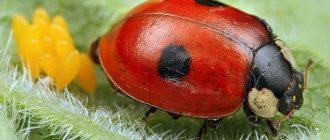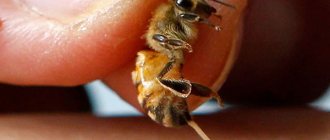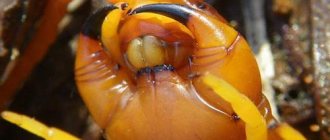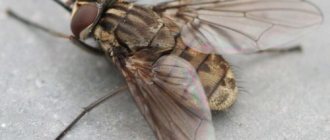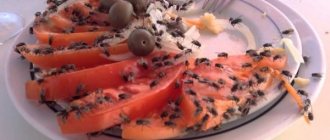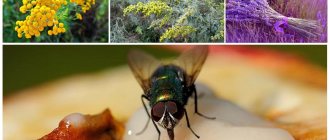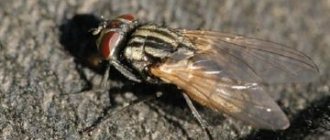Flies constantly annoy humans during the warm season. And all measures to combat them generally give a short-term effect, since these insects are able to penetrate into an apartment or house without much difficulty.
The main function of flies is reproduction. Therefore, females lay eggs in any suitable places and after some time larvae emerge from them. And since maggots feed on many foods that humans eat, the likelihood of them being swallowed is quite high. Therefore, it is worth understanding what this means for human health.
Where do flies lay their eggs?
Females initially worry about future offspring. Therefore, flies lay eggs where the larvae can fully feed and develop immediately after birth, since without food they die after 2 days.
In nature, this is usually organic waste of a liquid consistency, since the mouthparts of maggots are not designed for solid food. At home, the fly tries to lay eggs on human food.
Receptors on the legs, which act as an organ of touch, help the insect find the optimal place for its offspring. Then the fly uses its proboscis to check the consistency and taste of the product, and only after that it lays eggs.
Contaminated Meat
Suitable for this:
- meat;
- fish;
- fruits;
- vegetables;
- offal;
- cottage cheese;
- cheese.
Ready-made meals based on cereals can also serve as food for offspring. In order for an insect to lay eggs, it is quite enough to leave food on the table for a short time during the warm period of the year.
Green blowfly
This is a beautiful fly of a glossy emerald color with smoky wings that have a faint openwork pattern. The length of the green fly usually does not exceed 8 mm. It has large reddish eyes, a rounded belly and white cheeks.
The habitat of the green blowfly is places of all kinds of sewage, decomposing animal corpses, manure, waste, but sometimes they are also found in flowering plants that have a strong aroma. The food consists of rotting organic matter, where it lays its eggs.
One female is capable of laying approximately 180 grayish or light yellow eggs, which she tries to hide in carrion as deep as possible. The larvae are born after 6-48 hours and continue to develop there for another 9 days. They then move into the soil to develop into a pupa. Depending on weather conditions, an adult fly is formed within 10-17 days.
Types of larvae
There are about 3.5 thousand species of flies in nature, but only a few of them penetrate into a person’s home. Finding favorable conditions here, they lay eggs, from which larvae subsequently emerge.
Maggot
In addition to the larvae of ordinary houseflies, the following species can be found in an apartment:
- Maggot . The length of the insect reaches 15 mm. This species is the offspring of the blue carrion fly. Maggots can appear in meat and fish.
- Gozzer . This is the larva of the black-headed blue fly. Characterized by rapid pupation. The size of the insect at the last stage of development reaches 20 mm.
- Gordini . The maggot of a gray blowfly, the size of which reaches 20-25 mm. The larva quickly pupates.
- Pinka . This species is the offspring of the green blowfly. The body length of the larvae does not exceed 10 mm.
- FIFA . Lucilia fly maggot. Belongs to the category of frost-resistant species. The length of the larva does not exceed 12 mm.
How to protect an animal
It is impossible to prevent a cat from catching flies, so it is best to prevent their appearance and spread in the house. This can be done using:
- Sticky tapes. Such “traps” will reduce the number of insects in the apartment, thereby preventing the pet from catching them.
- Fumigators. The device repels pests, preventing them from entering the room.
- Folk methods. It is best to place basil or cloves throughout the rooms. Thanks to the aroma of plants, flies will leave the apartment.
To avoid the appearance of helminths, pets need to be vaccinated 2 times a year. You should also periodically show the animal to the veterinarian, even if it is healthy.
What do they look like?
Regardless of the type of fly, their eggs and larvae are similar in many ways. The difference can only be in the size and shades of color of the larvae. When magnified, a fly egg resembles the color and shape of a grain of rice. Its size is about 1-1.5 mm.
The fly larva is born approximately 2 mm in size. For each molt, it doubles in size and at the pre-pupation stage elongates to its maximum size. The weight of an adult maggot is 22-27 g, depending on the species.
The larvae can be gray, beige or yellowish in color. They have a segmented elongated body. Insects move due to false legs in the form of convex growths, which are located on the sides of the body. The insect's body consists of a head capsule, thoracic and abdominal regions. In the front part there is a mouthparts with retractable hooks. The larval chest consists of 3 segments, and the remaining 10 belong to the abdominal section.
The prepupa of a fly initially has the same color as the larva. But as she gets older, her skin hardens and darkens. The insect pupa has the shape of a barrel with pronounced transverse circular notches. It is dark brown in color.
Gray blowfly
This fly is also called a sarcophagus. She is carrion. This is a large fly, its length reaches 25 millimeters. Gray blowflies are, as the name implies, gray in color with a darker checkered or line pattern, with a yellowish-white head “divided” by a black stripe. The eyes are red, and there are white longitudinal lines on the belly. The body shape is oblong, the abdomen is covered with large bristles, and the legs are shaggy.
Gray blowflies are rare guests in a human home and appear there only if they have something to profit from there. The sense of smell of these flies is very developed, and they are able to smell the smell of rotting meat at a very long distance. Moreover, they only need to touch the surface of the meat for many small worms to immediately begin to move on it.
Female gray blowflies are viviparous and lay their larvae primarily in carrion. But there are representatives of this family, the larva of which is capable of developing in rotting fruit, feces or other decomposing organic matter. There are also types of flies whose larvae are capable of parasitizing other living organisms.
The larva of this fly is characterized by extraintestinal digestion. Sometimes she is able to feed on the larvae of other insects or practice cannibalism. The blowfly larva lives on carrion for up to 10 days, after which it moves into the soil, where it turns into a pupa, and then into an adult fly.
The pupa of a blowfly can hibernate; for example, the pupae of some species of sarcophagus are able to “sleep” through the entire winter and turn into an adult only in late spring.
The blowfly feeds on the nectar of flowers, and at the same time pollinates them, carrying pollen on its shaggy legs.
The attitude towards gray blowflies, as well as other carrion species, cannot be unambiguous. Being carriers of infectious diseases, they also serve as a kind of orderlies in nature. And forensic criminologists are able to determine the time of death by the age of the larvae in a decomposing corpse.
What happens if you eat a fly larva?
In most cases, if you eat a fly larva, nothing bad happens. However, another development of events is also possible, which will cause serious health problems.
Myases
This parasitic disease can be caused by the larvae of the gray blowfly and wohlfarth fly. This occurs against the background of a weakened immune system and disruption of the digestive system. In this case, if a person eats a larva, it is not processed in the stomach, but enters the systemic bloodstream and any internal organ. As a result, this leads to the development of an inflammatory process and can cause weakness, fever and other health complications.
Miaz
Intestinal myiases
This type of disease develops when larvae deposited by a fly enter the human intestine. This causes inflammation of the organ mucosa, accompanied by pain in the abdomen, diarrhea, and vomiting.
The disease can develop if you swallow the larva of a housefly, housefly, blue blowfly, or cheese fly. This occurs with reduced acidity of gastric juice and aerophagia.
In most cases, the larvae die in the human body and come out with vomiting and excrement; in rare cases, surgical intervention is required.
Intestinal myiasis
Salmonella
Swallowed fly larvae can be carriers of salmonellosis. This infectious disease is accompanied by a sharp increase in body temperature, diarrhea, fever, and loose stools.
In most cases, the disease does not require special treatment and goes away on its own with diet and drinking plenty of fluids.
Salmonella
Bacterial poisoning
Flies may visit multiple food sources throughout the day, and they may carry harmful bacteria that they have collected from human or animal waste.
They can transfer these bacteria to the food people eat. Larvae that develop in contaminated food can ingest these bacteria. People who eat this contaminated food or maggots are also exposed to the bacteria and may feel unwell.
Salmonella and E. coli are examples of bacteria that flies and maggots can transmit to humans.
Salmonella
Salmonella is one of the most common causes of foodborne illness. Symptoms of salmonella infection include:
- abdominal cramps
- nausea and vomiting
- diarrhea
- fever
Symptoms usually begin 12 to 72 hours after a person ingests the bacteria, and the illness usually lasts 4 to 7 days.
People with salmonella poisoning often get better without treatment. However, frequent vomiting and diarrhea can lead to severe dehydration and sometimes hospitalization. Therefore, it is important for people with salmonella poisoning to drink plenty of fluids, including clear broths and fruit juices, to replace lost fluids and electrolytes.
E. coli poisoning
There are many different strains of E. coli. While most strains are harmless, some can cause food poisoning.
Here are the symptoms of E. coli poisoning:
- stomach cramps
- diarrhea that may contain blood
- vomit
- slight increase in body temperature, usually below 38.3°C
These symptoms usually develop 1–10 days after bacteria enter the digestive tract and may last 5–7 days.
E. coli infections can vary in severity from very mild to severe, and can sometimes even be life-threatening. As with salmonella poisoning, people need to drink plenty of fluids to prevent dehydration.
Fighting fly larvae
To prevent the appearance of larvae in the house, you need to keep it clean so that flies cannot lay eggs. It is necessary to take out the trash in a timely manner, hide food in the refrigerator, put away pet food and equip windows with protective nets.
Maintain cleanliness
It is also necessary to take into account that for the development of maggots, a temperature within +12...300C is required. If you are not sure of the quality of the products, you need to heat treat them. The larvae die at temperatures above +500C.
The dangers of your pet eating flies
A cat that swallows a fly may suffer from:
- Insect bite. This applies primarily to horseflies and gadflies. The insect can sting a pet in the tongue or larynx.
- Helminth infections. Flies are carriers of germs and worms. Once in a favorable environment, they begin to actively develop, thereby causing harm to health.
Important: in case of a bite, swelling of the larynx is possible. Without timely assistance, the pet will suffocate.
A housefly is not capable of biting a cat when he is hunting for it, but a gadfly or a live fly can do this.
There are also indirect dangers associated with the process of hunting insects, namely:
- the cat is capable of falling out of a window or balcony;
- an animal may break a vase and then injure itself on the fragments.
To avoid problems, it is best to remove breakable items and close windows.
Do people intentionally eat fly larvae?
Sardinian cheese Katzumarza has a unique pungent taste. This is achieved due to the presence of fly larvae in its composition. According to the technological process, at an early stage of its production, it is necessary to remove the top crust to attract the attention of flies. Penetrating inside the cheese, they lay eggs, and the larvae live and feed in it for several months. It is the excrement of maggots that gives the final product its unique taste.
However, the European Community for Food Safety has now banned the sale of Katsumartsa cheese, citing a high risk to human health.
Intestinal myiasis
When a person becomes infected with fly larvae, intestinal myiasis occurs. The larvae live on or inside a person and survive by feeding on his tissues.
Intestinal myiasis is a type of myiasis that can occur when a person eats a fly larva that survives in the gastrointestinal tract. Some people with intestinal myiasis do not experience any symptoms and may only realize they are infected after noticing larvae in their stool.
However, here are some symptoms of intestinal myiasis that you may experience:
- abdominal pain
- nausea and vomiting
- itching in the anus
- bleeding from the rectum
Myiasis is not common in developed countries and occurs primarily in tropical and subtropical countries, including Africa and South America. However, a person may develop myiasis as a result of traveling to these countries.
Consequences
If a person accidentally swallows an adult fly or eggs of a fly, then usually nothing bad happens. Insects consist of protein and chitinous shell, which are easily broken down by gastric juice or excreted naturally.
Some people have an individual reaction in their digestive tract to fly eggs. The painful condition manifests itself in the form of:
- stomach ache;
- nausea;
- vomiting;
- stomach upsets.
If symptoms persist for more than 2–3 hours, and health worsens, then call a doctor as soon as possible for the victim.
The real danger to people is the larvae of gray blowflies, which cause myiases - parasitic diseases of the skin, intestines, stomach, respiratory system, vision, and hearing. However, such a lesion is typical for countries in Africa and South America, where this type of fly lives.
Under normal conditions, even if you swallow a fly, its eggs or larvae, it will not have any serious consequences for the body.
